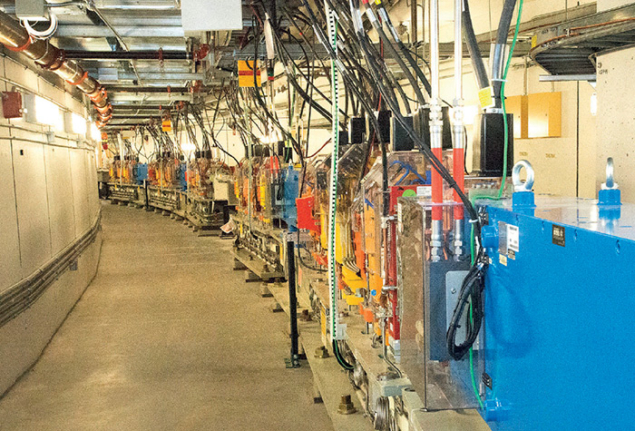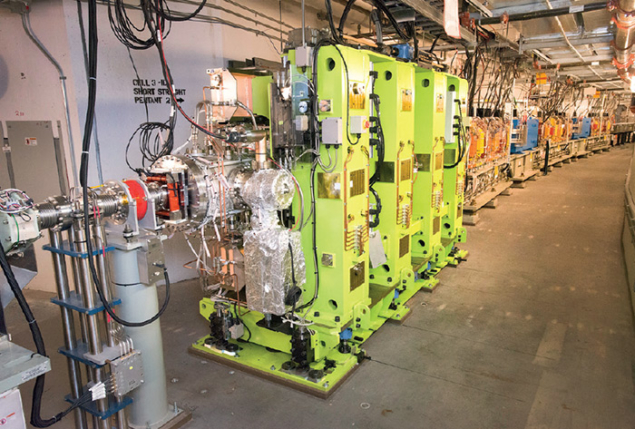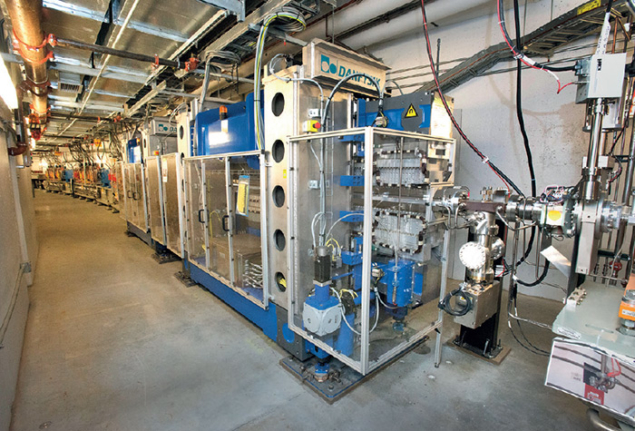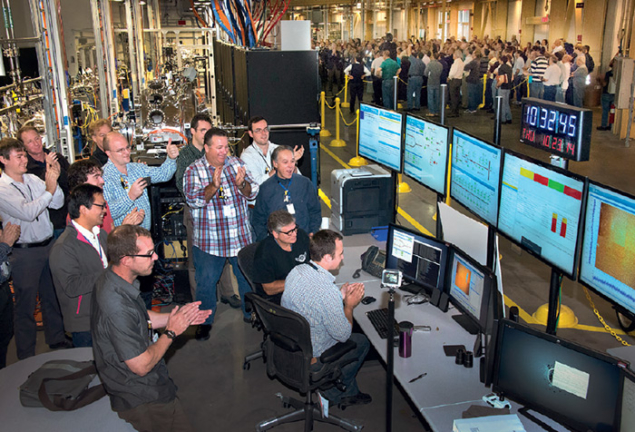NSLS-II will offer 10,000 times the brightness of its predecessor.

Image credit: Brookhaven National Laboratory.
An era came to an end on 30 September 2014, when the National Synchrotron Light Source (NSLS) ended its last run and dumped its last beam after more than 30 years of operation at Brookhaven National Laboratory. NSLS was the first of the modern synchrotron light sources, and had an enormous impact on synchrotron-light-based science during the past decades. It contributed a wealth of pioneering scientific results, including work that resulted in two Nobel prizes. The following day, 1 October, a new era began for Brookhaven, with the start-up of the new facility, NSLS-II, which is designed to provide the brightest beams ever produced by a synchrotron light source.

Image credit: Brookhaven National Laboratory.
The mission for a follow-up to NSLS was to provide a factor of 10 more flux and up to four orders of magnitude more brightness relative to the earlier machine (where brightness is defined as the number of photons per second divided by the beam cross-section and the divergence at the emission points, integrated over a narrow bandwidth of 1%). It was to be capable of achieving energy resolution of a fraction of a milli-electron-volt and spatial resolution on the nanometre scale. This ambition was acknowledged in 2005, when NSLS-II received CD-0, the first of five “critical decisions” for the construction of any new science facility funded by the US Department of Energy (DOE). The new light source was to enable novel science opportunities in all fields of synchrotron-radiation-based science, and would allow experiments that were not possible at any of the other facilities at that time. The project went swiftly through the design and R&D phase with critical decisions CD-1 and CD-2, and in June 2009 CD-3 was approved, allowing construction of the facility to begin.

Image credit: Brookhaven National Laboratory.
The NSLS-II electron storage ring consists of 30 double-bend achromates (DBA) separated by 15 long (9.3 m) and 15 short (6.6 m) straight sections for insertion devices, which are the source of ultra-bright synchrotron radiation. The ring is designed for a beam energy of 3 GeV. To achieve the desired high brightness based on a horizontal beam emittance of εx = 0.8 π nrad m, it has a large circumference of 792 m. The bending magnets are fairly long (2.69 m) and weak (0.4 T). These design choices have two advantages. They allow the design of a stable lattice with a beam emittance close to the DBA minimum emittance, and at the same time, the synchrotron-radiation power of photons emitted in the bending magnets is fairly moderate (283 keV per turn per electron). This allows an efficient doubling of the radiation-damping rate, and therefore a reduction of the beam emittance by a factor of two, by the use of six 3.4-m-long damping wigglers with a peak field of 1.85 T.
NSLS-II has a conventional system of electromagnets for bending, focusing and nonlinear corrections. However, the field quality of these magnets is pushed beyond what has been achieved previously (ΔB/B = 10–5 – 10–4 at r = 25 mm). Further, the alignment of the magnetic centres with respect to each other is held to unprecedentedly small tolerances with rms values of less than 10 μm.
The other critical parameter for high-brightness performance is the beam current of 500 mA. High beam current is obtained with an accelerating structure based on two single-cell 500-MHz superconducting cavities of the type known as CESR-B. This RF system offers advantages for beam stability because the structures exhibit weak parasitic RF modes and are superior for suppressing beam-loading effects.

Image credit: Brookhaven National Laboratory.
In addition, beyond-state-of-the-art instrumentation is required to control the orbital stability of the beam with its small beam sizes (σy = 3 μm at the insertion devices). Therefore, both a novel beam-position monitor system with a resolution and stability of less than 200 nm and a fast orbit-feedback system have been designed and implemented. These will limit the motion of the beam orbit to within 10% of the (vertical) beam size for frequencies up to 1 kHz.
The vacuum system is made of extruded, keyhole-shaped aluminium. The antechamber houses two non-evaporable getter strips for distributed pumping. The girder system is designed for high thermal stability and to avoid amplification of mechanical vibrations below 30 Hz.
All of the electronics and power supplies are located on the tunnel roof and are housed in sealed air-cooled racks, protecting the sensitive equipment from dust, temperature fluctuations, humidity and leaking cooling water. This protection is a major element of the strategy to achieve high operational reliability for the more than 1000 magnet power supplies, the beam-position monitors, controls and vacuum-control equipment. The facility aims for a reliability greater than 95% once its operation is matured fully.
The NSLS-II injector consists of a 200-MeV S-band linac, which feeds the 3-GeV combined-function booster synchrotron for on-energy injection in “top-off” mode, where frequent injection maintains the beam current. The booster synchrotron was designed and built by the Budker Institute of Nuclear Physics in Novosibirsk, and installed in collaboration with NSLS-II staff.
The civil construction with the accelerator tunnels and the ring-shaped experimental floor was completed in 2012. Installation of the accelerator components, which started in 2011, was completed in 2013.

Image credit: Brookhaven National Laboratory.
The commissioning of the linac was already possible in April 2012 and the commissioning of the booster synchrotron followed in December 2013. Storage-ring commissioning took place soon after, in April 2014. The commissioning time for the entire complex was remarkably short, the superb robustness and reproducibility of the machine being demonstrated by the fact that restarts are possible only a few hours after shutdowns.
The summer of 2014 saw the installation of the first NSLS-II insertion devices. Three pairs of 3.4-m-long damping wigglers with peak fields of 1.85 T not only provide a factor of two in emittance reduction by enhanced radiation damping, they are also powerful sources (195 kW at a beam current of 500 mA) of photons up to energies of 100 keV. The workhorses of NSLS-II are in-vacuum undulators with a period of 20–23 mm and an extremely small gap height of 5 mm. Four such devices up to 3 m in length are part of the initial installation. There is also a pair of 2-m-long elliptical polarizing undulators (EPUs). The insertion devices were commissioned with their corresponding front-end systems during autumn 2014.
An initial suite of six beamlines is also part of the scope of the NSLS-II project. These beamlines are based on state-of-the-art – or beyond – beamline technology. They cover a range of synchrotron-light experimental techniques, including powder diffraction (XPD), coherent hard X-ray scattering (CHX), nano-focus imaging (HNX), inelastic X-ray scattering with extreme energy resolution < 1 meV (IXS), X-ray spectroscopy (SRX) and coherent soft X-ray scattering (CSX). All of these beamlines have started technical commissioning. The first light emitted by the NSLS-II EPU was observed on 23 October in the CSX beamline, followed by similar events for the other beamlines.

Image credit: Brookhaven National Laboratory.
At the same time that the science commissioning of the existing beamlines at NSLSI-II is taking place, nine further insertion-device beamlines are under construction. The first three, known as the ABBIX beamlines, are scheduled to start up in the spring of 2016. They are specialized for biological research. The other six insertion-device beamlines – the so-called “NEXT” beamlines – are planned to start up the following autumn. Finally, there is an ongoing programme that consists of reusing NSLS equipment and integrating it into five new beamlines (NxtGen) that will receive bending-magnet radiation. As the field of the NSLS-II dipole magnets is weak, some of the source points are equipped with a wavelength-shifter consisting of a three-pole wiggler with 1.2 T peak field.
A number of non-Brookhaven institutions have responded positively to the opportunity to work with NSLS-II, and they will develop five additional beamlines in collaboration with NSLS-II staff. Therefore by 2018, NSLS-II will run with 27 beamlines and will have recovered from the reduction in the scientific programme between the shutdown of NSLS and the development period of the NSLS-II user facility. In its final configuration, the NSLS-II facility will host more than 60 beamlines.
The construction of NSLS-II within budget ($912 million) and to schedule is the result of excellent teamwork between scientists, engineers and technicians. In a ceremony on 6 February, the US secretary of energy, Ernest Moniz, dedicated the new facility. The first science results from NSLS-II were reported as early as March (Wang et al. 2015), and the science programme will start for most beamlines in the summer. The bright future of the NSLS-II era has begun.
• NSLS-II was constructed under DOE contract No. DE-AC02-98CH10886. For further information, visit www.bnl.gov/ps/nsls2/about-NSLS-II.php.








